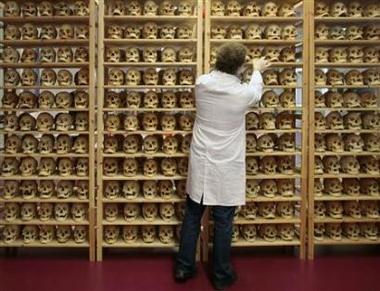"Beauty salon for the dead"
(Reuters)Updated: 2006-11-20 12:46
GUBEN, Germany - A disused factory in an economically depressed east German town has been turned into a "beauty salon for the dead" by anatomist Gunther von Hagens.
|
|
Von Hagens's "Body Worlds" exhibition of "plastinated" human bodies has caused controversy in several European cities where it has toured.
Visitors to his factory in Guben, on the border with Poland, are also treated to a display of anatomical models, like the ones used in "Body Worlds," together with a ghoulish show of malformed organs and diseased tissues.
Once named Dr. Death by Germany's Spiegel magazine, he defended his unconventional business on Thursday.
"I am a dresser of corpses who takes corpses and turns them into useful objects. This is an extension beyond death of the trend for beauty treatments," he said.
The eccentric man, invariably seen sporting a wide-brimmed hat, told reporters at the opening of his new center that the slices of bodies which he sells to schools and universities were no different than a slice of meat sold on a slab.
Named the Plastinarium after his unique resin-based process, the new center will create around 200 jobs for a town hit by high unemployment since the collapse of communism.
Aided by scientists, the workers will coat the bodies of donors in hard resins before slicing them into cross-sections to be sold around the world.
A full frontal section of a human would cost 7,000 euros ($9,000), von Hagens said, adding that depending on how a body was cut it could yield up to 600 sections of various sizes.
"I am not dreaming but I am convinced that in three to five years we will be able to produce between half to a million slices a year," he said, adding that would require around half the 80 donor bodies they expect to receive in Germany by then.
DIGNITY OF THE DEAD
Singing "We shall overcome" a group of around 20 protestors campaigned against the center, arguing that von Hagens disturbed the dignity of the dead.
"Von Hagens is using the scientific value of his work as a front for his money-making activities," said 78-year-old retired priest Egfred Brachmann. "We don't need this in Guben. He is disturbing the dead in order to satisfy people's curiosity."
Inside the four-story, red-brick factory, clusters of workers crowd round bodies in various stages of dissection.
One man, wearing surgical overalls, hovers over dozens of sacks of human bones under a sign which reads: bleaching. At the next station on the visitor's tour, three workers pick at the resin-coated fibers of a body lying on a surgical gurney.
While protesters have their problems with von Hagens' methods, his new employees, many of whom were unemployed for years, are happy to obey their new boss, who was born in Poland and later defected west from communist East Germany.
"I trained as a nurse and then I was a surgical theatre assistant and so this job is not a problem at all for me," said 52-year-old Ilona Wolfram, a Guben resident who was in and out of jobs for 15 years.
Colleague Daniel Mettke agreed: "I spent two years on unemployment benefits without a future and without prospects."
|
||
|
||
|
|

